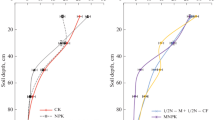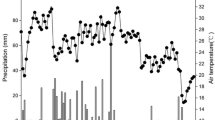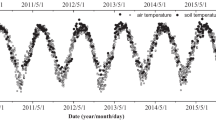Abstract
Purpose
The aim of this study was to understand the effect of nitrogen fertilization on soil respiration and native soil organic carbon (SOC) decomposition and to identify the key factor affecting soil respiration in a cultivated black soil.
Materials and methods
A field experiment was conducted at the Harbin State Key Agroecological Experimental Station, China. The study consisted of four treatments: unplanted and N-unfertilized soil (U0), unplanted soil treated with 225 kg N ha−1 (UN), maize planted and N-unfertilized soil (P0), and planted soil fertilized with 225 kg N ha−1 (PN). Soil CO2 and N2O fluxes were measured using the static closed chamber method.
Results and discussion
Cumulative CO2 emissions during the maize growing season with the U0, UN, P0, and PN treatments were 1.29, 1.04, 2.30 and 2.27 Mg C ha−1, respectively, indicating that N fertilization significantly reduced the decomposition of native SOC. However, no marked effect on soil respiration in planted soil was observed because the increase of rhizosphere respiration caused by N addition was counteracted by the reduction of native SOC decomposition. Soil CO2 fluxes were significantly affected by soil temperature but not by soil moisture. The temperature sensitivity (Q 10) of soil respiration was 2.16–2.47 for unplanted soil but increased to 3.16–3.44 in planted soil. N addition reduced the Q 10 of native SOC decomposition possibly due to low labile organic C but increased the Q 10 of soil respiration due to the stimulation of maize growth. The estimated annual CO2 emission in N-fertilized soil was 1.28 Mg C ha−1 and was replenished by the residual stubble, roots, and exudates. In contrast, the lost C (1.53 Mg C ha−1) in N-unfertilized soil was not completely supplemented by maize residues, resulting in a reduction of SOC. Although N fertilization significantly increased N2O emissions, the global warming potential of N2O and CO2 emissions in N-fertilized soil was significantly lower than in N-unfertilized soil.
Conclusions
The stimulatory or inhibitory effect of N fertilization on soil respiration and basal respiration may depend on labile organic C concentration in soil. The inhibitory effect of N fertilization on native SOC decomposition was mainly associated with low labile organic C in tested black soil. N application could reduce the global warming potential of CO2 and N2O emissions in black soil.



Similar content being viewed by others
References
Ågren GI, Bosatta E, Magill AH (2001) Combining theory and experiment to understand effects of inorganic nitrogen on litter decomposition. Oecologia 128:94–98
Bolinder MA, Angers DA, Giroux M, Laverdière MR (1999) Estimating C inputs retained as soil organic matter from corn (Zea Mays L.). Plant Soil 215:85–91
Bowden RD, Davidson E, Savage K, Arabia C, Steudler P (2004) Chronic nitrogen additions reduce total soil respiration and microbial respiration in temperate forest soils at the Harvard Forest. Forest Ecol Manage 196:43–56
Cao M, Woodward FI (1998) Dynamic responses of terrestrial ecosystem carbon cycling to global climate change. Nature 393:249–252
Carreiro MM, Sinsabaugh RL, Repert DA, Parkhurst DF (2000) Microbial enzyme shifts explain litter decay responses to simulated nitrogen deposition. Ecology 81:2359–2365
Chen SP, Lin GH, Huang JH, He M (2008) Responses of soil respiration to simulated precipitation pulses in semiarid steppe under different grazing regimes. J Plant Ecol 1:237–246
Davidson EA, Verchot LV, Cattânio JH, Ackerman IL, Carvalho JEM (2000) Effects of soil water content on soil respiration in forests and cattle pastures of eastern Amazonia. Biogeochemistry 48:53–69
Ding WX, Yu HY, Cai ZC, Han FX, Xu ZH (2010) Responses of soil respiration to N fertilization in a loamy soil under maize cultivation. Geoderma 155:381–389
Dörr H, Münnich KO (1987) Annual variation in soil respiration in selected areas of the temperate zone. Tellus 39B:114–121
Fog K (1988) The effect of added nitrogen on the rate of decomposition of organic-matter. Biol Rev Camb Philos Soc 63:433–462
Food and Agricultural Organization of the United Nations (FAO) (2008) FAOSTAT Database http://www.fao.org/faostat/. Accessed 10 Oct 2010
Food and Agricultural Organization of the United Nations (FAO) (2010) Current world fertilizer trends and outlook to 2014. Rome
Frey SD, Knorr M, Parrent JL, Simpson RT (2004) Chronic nitrogen enrichment affects the structure and function of the soil microbial community in temperate hardwood and pine forests. Forest Ecol Manage 196:159–171
Giardina CP, Binkley D, Ryan MG, Fownes JH, Senock RS (2004) Belowground carbon cycling in a humid tropical forest decreases with fertilization. Oecologia 139:545–550
Han XZ, Wang SY, Veneman PLM, Xing BS (2006) Change of organic carbon content and its fractions in black soil under long-term application of chemical fertilizers and recycled organic manure. Commun Soil Sci Plant Anal 37:1127–1137
Huang Y, Sun WJ (2006) Changes in topsoil organic carbon of croplands in mainland China over the last two decades. Chin Sci Bull 51:1785–1803
Huang Y, Sun WJ, Zhang W, Yu YQ, Su YH, Song CC (2010) Marshland conversion to cropland in northeast China from 1950 to 2000 reduced the greenhouse effect. Glob Chang Biol 16:680–695
Institute of Soil Science of the Chinese Academy of Sciences (1978) Soils of China. Science Press, Beijing (in Chinese)
Intergovernmental Panel on Climate Change (2007) Climate change 2007: the physical science basis. Cambridge University Press, New York
Janssens IA, Dieleman W, Luyssaert S, Subke JA, Reichstein M, Ceulemans R, Ciais P, Dolman AJ, Grace J, Matteucci G, Papale D, Piao SL, Schulze ED, Tang J, Law BE (2010) Reduction of forest soil respiration in response to nitrogen deposition. Nat Geosci 3:315–322
Keeler BL, Hobbie SE, Kellogg LE (2009) Effects of long-term nitrogen addition on microbial enzyme activity in eight forested and grassland sites: implications for litter and soil organic matter decomposition. Ecosystems 12:1–15
Kou TJ, Zhu JG, Xie ZB, Hasegawa T, Heiduk K (2007) Effect of elevated atmospheric CO2 concentration on soil and root respiration in winter wheat by using a respiration partitioning chamber. Plant Soil 299:237–249
Kuzyakov Y (2006) Sources of CO2 efflux from soil and review of partitioning methods. Soil Biol Biochem 38:428–448
Kuzyakov Y, Cheng W (2004) Photosynthesis controls of CO2 efflux from maize rhizosphere. Plant Soil 263:85–99
Lal R (2004) Offsetting China’s CO2 emissions by soil carbon sequestration. Clim Chang 65:263–275
Lee KH, Jose S (2003) Soil respiration, fine root production, and microbial biomass in cottonwood and loblolly pine plantations along a nitrogen fertilization gradient. Forest Ecol Manage 185:263–273
Li LJ, Zeng DH, Yu ZA, Fan ZP, Mao R (2010) Soil microbial properties under N and P additions in a semi-arid, sandy grassland. Biol Fertil Soils 46:653–658
Liang AZ, Zhang XP, Yang XM, Mclaughlin NB, Shen Y, Li WF (2009) Estimation of total erosion in cultivated black soils in northeast China from vertical profiles of soil organic carbon. Eur J Soil Sci 60:223–229
Liljeroth E, Van Veen JA, Miller HJ (1990) Assimilate translocation to the rhizosphere of two wheat lines and subsequent utilization by rhizosphere microorganisms at two soil nitrogen concentrations. Soil Biol Biochem 22:1015–1021
Liljeroth E, Kuikman P, Veen JA (1994) Carbon translocation to the rhizosphere of maize and wheat and influence on the turnover of native soil organic matter at different soil nitrogen levels. Plant Soil 161:233–240
Linn DM, Doran JW (1984) Effect of water-filled pore space on carbon dioxide and nitrous oxide production in tilled and nontilled soils. Soil Sci Soc Am J 48:1267–1272
Liu DL, Chan KY, Conyers MK (2009) Simulation of soil organic carbon under different tillage and stubble management practices using the Rothamsted carbon model. Soil Tillage Res 104:65–73
Lu RK (2000) Soil Agro−Chemical Analyses. Agricultural Technical Press of China, Beijing
Paré D, Boutin R, Larocque GR, Raulier F (2006) Effect of temperature on soil organic matter decomposition in three forest biomes of eastern Canada. Can J Soil Sci 86:247–256
Pietikäinen J, Pettersson M, Bååth E (2005) Comparison of temperature effects on soil respiration and bacterial and fungal growth rates. FEMS Microbiol Ecol 52:49–58
Post WM, Kwon KC (2000) Soil carbon sequestration and land-use change: processes and potential. Glob Chang Biol 6:317–327
Qiao YF, Han XZ, Miao SJ, Li HB, Wang SQ (2008) Carbon budget dynamic of growth and decline of farmland in black soil area. J Soil Water Conserv 22:96–99
Rochette P, Flanagan LB (1997) Quantifying rhizosphere respiration in a corn crop under field conditions. Soil Sci Soc Am J 61:466–474
Rousk J, Brookes PC, Bååth E (2009) Contrasting soil pH effects on fungal and bacterial growth suggest functional redundancy in carbon mineralization. Appl Environ Microbiol 75:1589–1596
Ruehr NK, Buchmann N (2010) Soil respiration fluxes in a temperate mixed forest: seasonality and temperature sensitivities differ among microbial and root–rhizosphere respiration. Tree Physiol 30:165–176
Schlesinger WH, Andrews JA (2000) Soil respiration and the global carbon cycle. Biogeochemistry 48:7–20
Trumbore S (2006) Carbon respired by terrestrial ecosystems—recent progress and challenges. Glob Chang Biol 12:141–153
Wagai R, Brye KR, Gower ST, Norman JM, Bundy LG (1998) Land use and environmental factors influencing soil surface CO2 flux and microbial biomass in natural and managed ecosystems in southern Wisconsin. Soil Biol Biochem 30:1501–1509
Wang CY, Wang SB, Gu JX, Shi Y, Chen X (2006) Soil respiration in maize fields in the lower reaches of Liaohe plain. J Agro-Environ Sci 25:1240–1244
Weitz AM, Linder E, Frolking S, Crill PM, Keller M (2001) N2O emissions from humid tropical agricultural soils: effects of soil moisture, texture and nitrogen availability. Soil Biol Biochem 33:1077–1093
Wildung RE, Garland TR, Buschbom RL (1975) The interdependent effect of soil temperature and water content on soil respiration rate and plant root decomposition in arid grassland soils. Soil Biol Biochem 7:373–378
Xia J, Wan S (2008) Global response patterns of terrestrial plant species to nitrogen enrichment. New Phytol 179:428–439
Xie ZB, Zhu JG, Liu G, Cadisch G, Hasegawa T, Chen CM, Sun HF, Tang HY, Zeng Q (2007) Soil organic carbon stocks in China and changes from 1980s to 2000s. Glob Chang Biol 13:1989–2007
Xing BS, Liu XB, Liu JD, Han XZ (2004) Physical and chemical characteristics of a typical Mollisol in China. Commun Soil Sci Plant Anal 35:1829–1838
Yan LM, Chen SP, Huang JH, Lin GH (2010) Differential responses of auto- and heterotrophic soil respiration to water and nitrogen addition in a semiarid temperate steppe. Glob Chang Biol 16:2345–2357
Yu JB, Liu JS, Wang JD, Liu SX, Qi XN, Wang Y, Wang GP (2004) Organic carbon variation law of black soil during different tillage period. J Soil Water Conserv 18:28–30
Yuste JC, Ma S, Baldocchi DD (2010) Plant–soil interactions and acclimation to temperature of microbial-mediated soil respiration may affect predictions of soil CO2 efflux. Biogeochemistry 98:127–138
Zhang Q, Zak JC (1998) Potential physiological activities of fungi and bacteria in relation to plant litter decomposition along a gap size gradient in a natural subtropical forest. Microb Ecol 35:172–179
Zhang JB, Song CC, Yang WY (2007) Tillage effects on soil carbon fractions in the Sanjiang Plain, Northeast China. Soil Till Res 93:102–108
Zhou X, Wan SQ, Luo YQ (2007) Source components and interannual variability of soil CO2 efflux under experimental warming and clipping in a grassland ecosystem. Glob Chang Biol 13:761–775
Acknowledgments
The authors acknowledge the practical help provided by Dr. Xingzhu Ma. Financial support for this study was provided by the Chinese Academy of Sciences (KZCX2–YW–439), the National Basic Research Program of China (2011CB100503), Natural Science Foundation of China (40921061, 41171190), and Natural Science Foundation of Jiangsu province (BK2008057).
Author information
Authors and Affiliations
Corresponding author
Additional information
Responsible editor: Thomas DeLuca
Rights and permissions
About this article
Cite this article
Ni, K., Ding, W., Cai, Z. et al. Soil carbon dioxide emission from intensively cultivated black soil in Northeast China: nitrogen fertilization effect. J Soils Sediments 12, 1007–1018 (2012). https://doi.org/10.1007/s11368-012-0529-6
Received:
Accepted:
Published:
Issue Date:
DOI: https://doi.org/10.1007/s11368-012-0529-6




